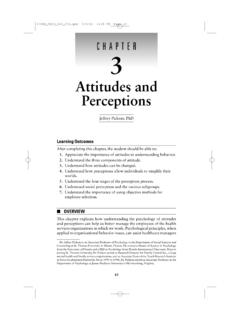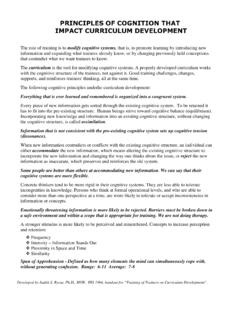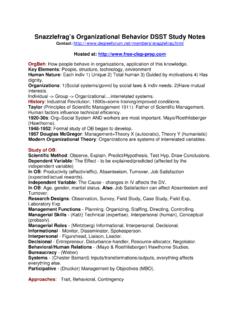Transcription of What Got You Here Won™t Get You There How …
1 1 What Got You Here Won t Get You There How successful people become even more successful Notes by Frumi Rachel Barr, MBA, Author: Marshall Goldsmith Publisher: Hyperion Copyright year: 2007 ISBN: 1-4013-0130-4 Author s Bio: Marshall Goldsmith is corporate America s preeminent executive coach. Goldsmith is one of a select few consultants who has been asked to work with more than eighty CEOs in the world s top corporations. He has helped implement leadership processes that have impacted more than one million people . Author s big thought: In this wonderful book Marshall discusses the key beliefs of successful leaders and also the behaviors that hold them back. He addresses the fundamental problems that come with success and the twenty habits that get in their way. Notes: Part 1: The Trouble with Success: In which we learn how previous success often prevents us from achieving more success Chapter 1: You are Here Marshall works as an executive coach with successful people who have a dented sense of proprioception which is the sense of how you are perceived by others.
2 They look at the map of their life and career. It tells them, You Are Here. But they don t accept it. They may resist the truth. Marshall shows these people what their colleagues at work really think of them. It s called feedback. It s the only tool needed to show people , You Are Here. It doesn t take much to get people oriented and back on the right path. The problems we will be looking at in this book are not life-threatening diseases (although ignored for too long they can destroy a career). They re not deep-seated neuroses that require years of therapy or tons of medication to erase. more often than not, they are simple behavioral tics bad habits that we repeat dozens of 2times a day in the workplace which can be cured by (a) pointing them out. (b) showing the havoc they cause among the people surrounding us, and (c) demonstrating that with a slight behavioral tweak we can achieve a much more appealing affect. We re talking about people who do one annoying thing repeatedly and don t realize that this small flaw may sabotage their otherwise golden career.
3 And, worse, they do not realize that (a) it s happening and (b) they can fix it. Here is a place where you can be a success in spite of some gaps in your behavior or personal makeup. That s why you want to go There . There is a place where you can be a CEO who is viewed as a great leader because he didn t get in the way of his people . Look at you own personal map. Trace the distance between your vision of here and There . You have to understand that what got you here won t get you There . Chapter 2: Enough About You There is no correlation between an individual s standing in the corporate pyramid and what his coworkers think of his interpersonal skills. Middle managers are no less immune than CEOs to being perceived as arrogant, inattentive, rude, and unfoundedly omniscient. Marshall trains people to behave effectively in the workplace by enrolling them in a simple but brutal regimen. First, he solicits 360-degree feedback from their colleagues as many as he can talk to, up, down, and sideways in the chain of command, often including family members for a comprehensive assessment of their strengths and weaknesses.
4 Then he confronts them with what everybody really thinks about them. Assuming they accept this information, agree they have room to improve, and commit to changing that behavior, and then he shows them how to do it. He helps them apologize to everyone affected by their flawed behavior and ask the same people for help in getting better. He helps them advertise their efforts to get better because you have to tell people that you re trying to change; they won t notice it on their own. Then he helps them follow up religiously every month or so with their colleagues because it s the only honest way to find out how you re doing and it also reminds people that you re still trying. As an integral part of this follow-up process, he teaches people to listen without prejudice to what their colleagues, family members, and friends are saying that is, listening without interrupting or arguing. The only proper response to whatever they hear is gratitude. Finally, he teaches the miracle of feedforward which is his special methodology for eliciting advice from people on what they can do to get better in the future.
5 After 12-18 months, they get better not only in their own minds, but ore importantly in opinions of their coworkers. 3 This book is aimed at everyone who wants to get better at work, at home, or any other venue. Chapter 3: The Success Delusion, or Why We Resist Change All of us in the workplace delude ourselves about our achievements, our status, and our contributions. This delusional belief instills us with confidence, erases doubt, and blinds us to the risks and challenges in our work. Our delusions become a serious liability when we need to change and when someone tries to make us change our ways. First we think the other party is confused. Second we go into denial mode. The criticism does not apply to us, or else we wouldn t be so successful . Finally we attack the other party and discredit the messenger. Those are just the surface responses the denial mechanisms. Couple them with the very positive interpretations that successful people assign to (a) their past performance, (b) their ability to influence their success (rather than just being lucky), (c) their optimistic belief their success will continue in the future, and (d) their sense of control over their own destiny ( as opposed to being controlled by external forces).
6 And you make it tough for us to change. Belief 1: I have succeeded successful people believe in their skills and talents Whatever the evidence, if it has a happy ending that makes us look good, we ll replay it to ourselves and retell it to anyone who ll listen. No matter how much they respect their teammates, when the team achieves great results, they tend to believe that their contribution was more significant than facts suggest. This I have succeeded belief, positive as it is most times, only becomes an obstacle when behavioral change is needed. Belief 2: I Can Succeed successful people believe that they have the capability within themselves to make desirable things happen. successful people literally believe that through the sheer force of personality or talent or brainpower, they can steer a situation in their direction. people who believe they can succeed see opportunities where others see threats. They re not afraid of uncertainty or ambiguity. They embrace it.
7 They want to take greater risks and achieve greater returns. They see success for themselves and others as largely a function of people s motivation and ability not luck, random chance, or external factors. One of the greatest mistakes of successful people is the assumption, I am successful . I behave this way. Therefore, I must be successful because I behave this way! The challenge is to make them see that sometimes they are successful in spite of this behavior. 4 Belief 3: I Will Succeed. (I have the motivation to succeed) successful people have an unflappable optimism. As a result, they tend to pursue opportunities with an enthusiasm that others may find mystifying. It explains why successful people tend to be extremely busy and face the danger of over-commitment. Over-commitment can be as serious an obstacle as believing you don t need fixing or that your flaws are part of the reason you are successful . Belief 4: I Choose to Succeed successful people believe that they are doing what they choose to do, because they choose to do it.
8 Thy have a high need for self-determination. The more successful a person is, the more likely this is to be true. When we do what we choose to do, we are committed. When we do what we have to do, we are compliant. successful people have a unique distaste for feeling controlled or manipulated. I choose to succeed correlates perfectly with achievement in virtually any field. people don t stumble on success, they choose it. The more we believe our behavior is a result of our own choices and commitments, the less likely we are to want to change our behavior. Cognitive dissonance refers to the disconnect between what we believe in our minds and what we experience or see in reality. Yet cognitive dissonance works in favor of successful people when they apply it to themselves. The more committed we are to believing that something is true, the less likely we are to believe that it s opposite is true, even in the face of evidence that shows we may have chosen the wrong path. It s the reason successful people don t buckle and waver when times get tough.
9 Their commitment to their goals and beliefs allows them to view reality through rose-tinted glasses. That s a good in many situations. Of course, this same steadfastness can work against successful people when they should change course. These four success beliefs that we have the skills, the confidence, the motivation, and the free choice to succeed make us superstitious. Superstitious behavior comes from the mistaken belief that a specific activity that is followed by positive reinforcement is actually the cause of positive reinforcement. If something good happens after we do it, then we make a connection and seek to repeat the activity. Virtually all of us are superstitious, attaching too much value to bad behavior that we confusedly associate with our success. Getting out of this superstition trap requires vigilance. You must constantly ask yourself, Is this behavior a legitimate reason for my success or am I kidding myself? people will do something- including changing their behavior only if it can be demonstrated that doing so is in their own best interests as defined by their own values.
10 5 When you take self-volition out of the equation and forces beyond your control are involved, natural law applies. In order for me to get you to do what I want, have to prove that doing so will benefit you in some way, immediately or somewhere down the road. This is natural law. Every choice, big or small, is a risk-reward decision where your bottom-line thinking is, What s in it for me? Most people s resistance to change can be overcome by invoking natural law. Everyone, even the biggest ego in the room, has a hot button that can be pushed and that button is self-interest. If you press people to identify the motives behind their self- interest it usually boils down to four items: money, power, status, and popularity. These are the standard payoffs for success. Part two: The Twenty Habits That Hold You Back from the Top In which we identify the most annoying interpersonal issues in the workplace and help you figure out which ones apply to you Chapter 4: The Twenty Habits Peter Drucker said We spend a lot of time teaching leaders what to do.






